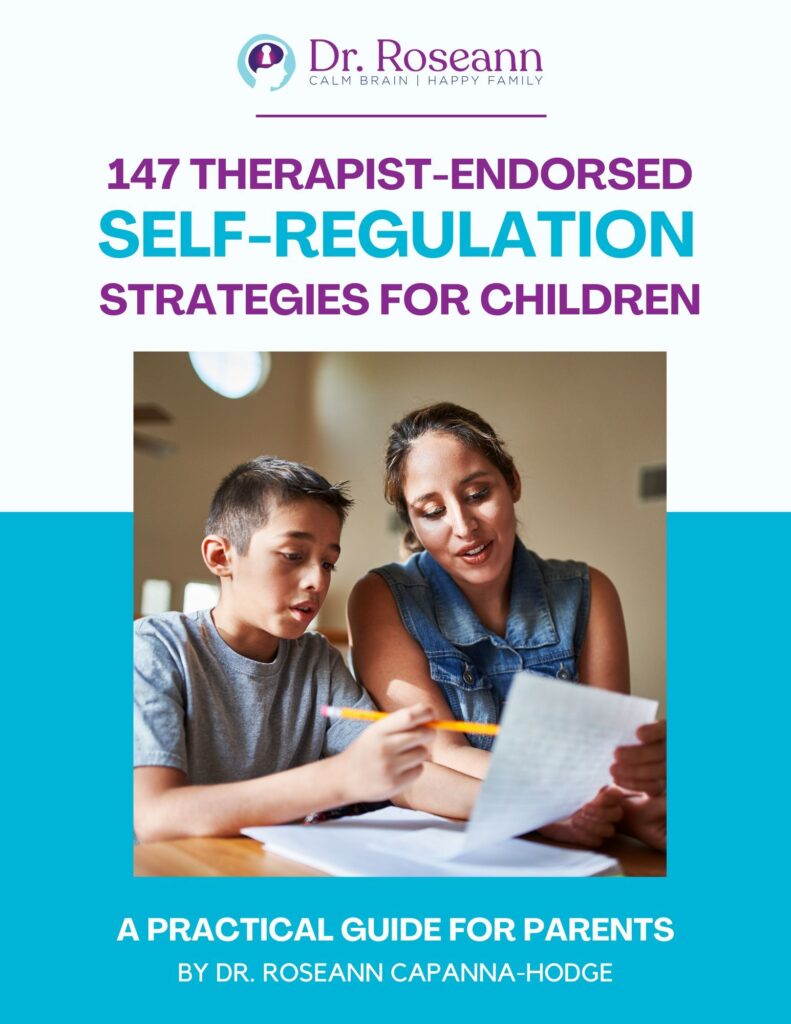The Neurodivergent Umbrella: A Guide to Understanding and Supporting Neurodiversity
Neurodivergence covers a broad spectrum of neurological variations that impact how individuals process information and interact with the world. These differences can manifest in various ways, including learning disabilities, dyslexia, ADHD, autism, and other cognitive variances.
Table of Contents
Chapter 1:
What is Neurodiversity?
Chapter 2:
Neurotypical vs Neurodivergent Brain
Chapter 3: Understanding Neurodivergent Perspectives
Chapter 4: Autism as a Neurodiverse Condition
Chapter 5: ADHD and Neurodivergence
Chapter 6: Learning Disability, Specific Learning Disability and Neurodivergence
Chapter 7: Learning Disabilities vs Specific Learning Disabilities
Chapter 8: Key Features of Specific Learning Disabilities
Chapter 9: Types of Learning Disabilities
Chapter 10: Key Characteristics of Dyslexia
Chapter 11: The Spectrum of Mental Health
Chapter 12: How Do You Know If Your Child is Neurodivergent?
Understanding the complexities of neurodiversity, including its diverse manifestations and the prevalent misconceptions surrounding it, is crucial for creating inclusive environments that support individuals with neurodivergent traits in school and work.
Parents and school and workplace environments are encouraged to learn the concepts of neurodivergence to provide tailored support and foster an inclusive educational environment that celebrates the unique strengths of their child and the perspectives of all neurodivergent individuals.
Chapter 1
What is Neurodiversity?
Neurodiversity covers various neurological variations that affect how individuals process information, perceive the world, and interact with others. Some common neurodivergences include autism spectrum disorder (ASD), attention deficit hyperactivity disorder (ADHD), and learning disabilities like dyslexia, dyspraxia, and more. Each condition presents unique strengths and challenges, shaping individuals' experiences and perspectives differently.
It's essential to recognize that neurodiversity is not limited to clinical diagnoses. Everyone's brain is unique, and variations in neurology exist on a continuum. Therefore, neurodiversity extends beyond traditional categories and includes a broad spectrum of cognitive differences.
Chapter 2
Neurotypical vs Neurodivergent Brain
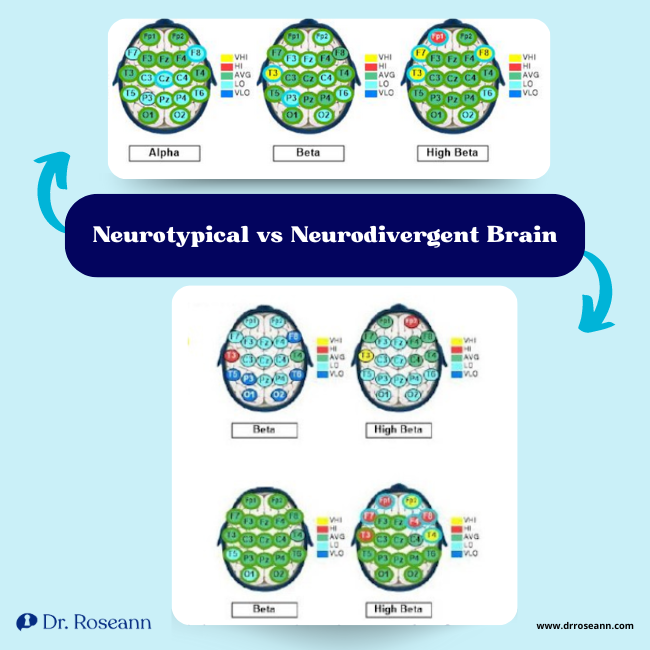
Neurotypical brains are often seen as the usual or normal kind. They typically follow the expected patterns for thinking, interacting with others, and communicating. They are usually marked by usual ways of processing information, behaving socially, and managing emotions. In my clinical experience, the neurotypical and neurodivergent brain processes information differently.
For most kids I work with, the neurotypical brain processes within the average range without a wide variety of highs or lows. For example, I worked with a boy named Cole, whose cognitive profile had scores ranging from 93 to 109. Everything in his profile was very average.
Now, what does neurodivergent mean? Neurodivergent brains exhibit variations from these typical patterns. These variations can include differences in sensory processing, attention regulation, social communication, and cognitive processing styles. Neurodivergent individuals may excel in certain areas while facing challenges in others, leading to a diverse range of strengths and difficulties.
For example, Isla was a neurotypical teen with AuDHD and had cognitive scores that ranged from 65 to 143. Her ability to pay attention to auditory stimuli was poor, but her visual skills were off the chart.
Understanding the distinctions between neurotypical and neurodivergent brains is essential for recognizing and accommodating the unique needs and strengths of neurodivergent individuals. Embracing neurodiversity involves appreciating the rich tapestry of cognitive differences and promoting environments that celebrate and leverage all individuals' unique perspectives and capabilities, regardless of their neurological makeup.
Chapter 3
Understanding Neurodivergent Perspectives
Neurodivergent individuals often experience the world in ways that differ from neurotypical norms. For example, autistic individuals may have heightened sensory sensitivities, difficulty with social communication, and intense focus on specific interests. People with ADHD might struggle with attention regulation, impulsivity, and hyperactivity. Those with learning disabilities may face reading, spelling, and processing written language challenges.
It's crucial to understand that these differences are not deficits but variations in cognitive functioning. Neurodivergent individuals possess unique strengths, such as creativity, attention to detail, problem-solving skills, and innovative thinking. By embracing these strengths and accommodating individual differences, we can create environments where neurodivergent individuals can thrive.
Chapter 4
Autism as a Neurodiverse Condition
Autism, officially termed Autism Spectrum Disorder (ASD), falls under the neurodivergence umbrella, as well as AuDHD. AuDHD is a combination of ADHD and ASD and is increasingly common. It is a complex neurodevelopmental condition characterized by various challenges related to social interaction, communication, and learning disability behavior. Individuals with ASD often display unique strengths and differences in how they perceive and interact with the world.
Key Components of Autism
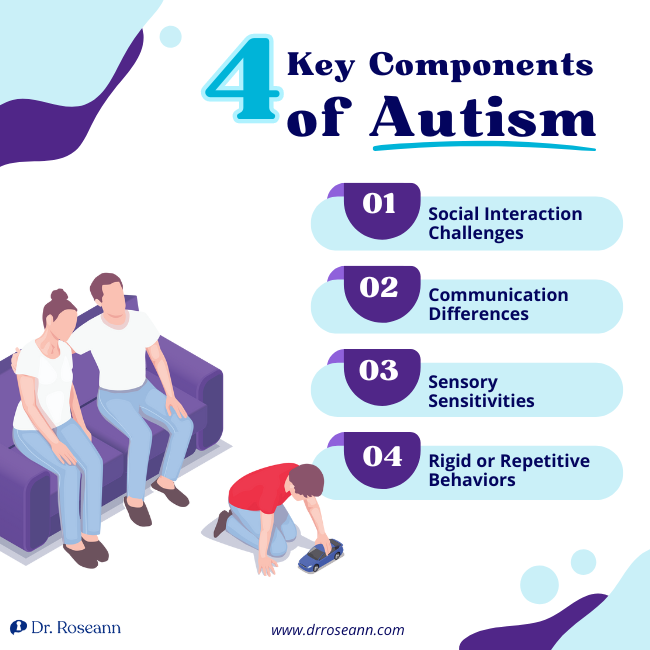
Social Interaction Challenges
Autistic people may struggle to navigate social cues, establish peer relationships, and engage in reciprocal communication. These difficulties can affect collaborative learning activities and require tailored approaches to foster social inclusion in educational settings.
Communication Differences
Language and communication variations are common in individuals with autism. Some individuals may have delayed speech, while others may have a rich vocabulary but struggle with pragmatic language use. Educators may need to implement alternative communication strategies to support effective learning and expression.
Sensory Sensitivities
Sensory sensitivities, such as hypersensitivity to sound, light, or touch, are common in autism. These sensitivities can impact an individual's concentration ability in a traditional classroom environment. Creating sensory-friendly spaces and considering sensory needs is crucial for optimizing the learning experience.
Rigid or Repetitive Behaviors
Individuals with autism may engage in repetitive behaviors or prefer routines. These behaviors could disrupt the conventional structure of a classroom. Flexibility in teaching methods and environmental accommodations can provide learning disability help and accommodate these preferences.
Chapter 5
ADHD and Neurodivergence
Attention-Deficit Hyperactivity Disorder (ADHD) qualifies as a form of neurodivergence due to its inherent differences in cognitive functioning and behavior compared to what is considered neurotypical. Neurodivergence refers to natural variations in neurological development that result in differences in cognition, behavior, and perception. ADHD represents one such variation, characterized by attention regulation, impulse control, and executive functioning challenges.
Children with ADHD often experience difficulties in maintaining focus, organizing tasks, and managing impulses, which can impact their academic, occupational, and social functioning. These challenges arise from differences in brain structure and function, particularly in areas responsible for attention, self-regulation, and executive functions such as planning and decision-making.
They may also need help in specific academic areas. A student with ADHD might struggle with organizational skills, impacting their ability to complete assignments. Neurodiversity advocates argue that ADHD, like other neurodivergent conditions, represents a valid and valuable variation of human cognition.
Chapter 6
Learning Disability, Specific Learning Disability and Neurodivergence
Learning disability and specific learning disability (SLD) are related terms often used interchangeably, but they have distinct meanings within the realm of education and psychology.
Learning Disabilities
A learning disability is an umbrella term encompassing many neurological conditions that can hinder an individual's ability to acquire, process, or express information effectively. Challenges may manifest across various academic domains within this expansive category, impacting reading, writing, mathematics, and comprehension skills.
The scope of learning disabilities extends beyond specific academic areas, potentially affecting social and emotional development. Dyslexia, dysgraphia, dyscalculia, and auditory processing disorder are among the diverse conditions falling under the umbrella of learning disabilities.
Specific Learning Disabilities
In contrast, specific learning disability (SLD) represents a narrower subset within the realm of learning disabilities, focusing specifically on challenges related to particular cognitive processes involved in academic learning.
Rather than covering difficulties across multiple domains, SLD focuses on specific areas of weakness, typically in reading, writing, or mathematics skills. For instance, individuals with dyslexia struggle primarily with reading, while those with dysgraphia encounter difficulties in writing.
Despite these challenges, individuals with SLD often demonstrate average or above-average intelligence, highlighting the selective nature of their learning difficulties. Diagnosis of SLD involves pinpointing these areas of weakness through thorough assessments to understand an individual's cognitive functioning and academic performance.
Chapter 7
Learning Disabilities vs Specific Learning Disabilities
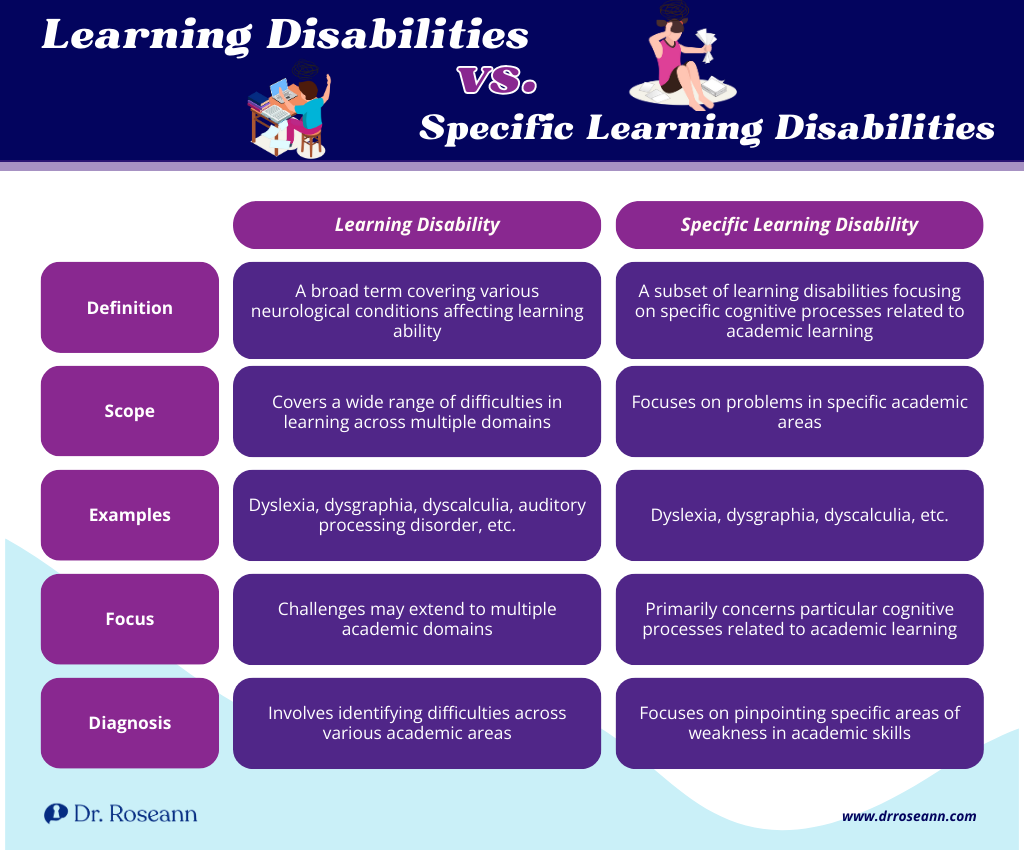
Chapter 8
Key Features of Specific Learning Disabilities
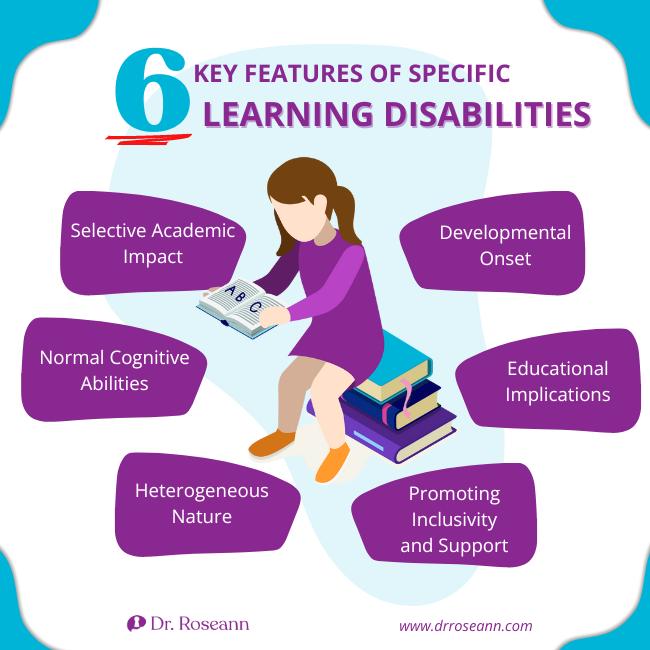
Selective Academic Impact
SLD manifests as difficulties in acquiring proficiency in particular academic areas. These challenges can include, but are not limited to, reading, writing, mathematics, and other essential learning domains.
Normal Cognitive Abilities
Crucially, individuals with SLD exhibit normal cognitive functioning in general intelligence, memory, and problem-solving. The learning challenges they encounter are distinct from any global intellectual impairment.
Heterogeneous Nature
SLD is not a singular condition but a diverse category covering various specific learning disorders. These disorders may include dyslexia, dysgraphia, dyscalculia, and other particular challenges affecting different facets of learning.
Developmental Onset
Specific Learning Disabilities typically manifest during the developmental stages of a child's education. Identifying and addressing these challenges early is essential for implementing effective interventions.
Educational Implications
Understanding and acknowledging SLD is paramount in educational settings. It prompts educators to tailor teaching methods, interventions, and accommodations to address the specific challenges faced by students. Individualized Education Programs (IEPs) and targeted support services are crucial in facilitating individuals' academic success and personal development with SLD. It is important to note that children identified as SLD can also have a specific clinical diagnosis.
Promoting Inclusivity and Support
By recognizing the heterogeneous nature of SLD, educational institutions and support systems can foster inclusivity and create environments where children with specific learning disabilities can thrive. Emphasizing strengths, providing assistive technologies, and employing evidence-based interventions provide a more supportive educational journey for those with SLD.
Chapter 9
Types of Learning Disabilities
Different learning disabilities manifest in various forms, covering a range of challenges that impact distinct cognitive functions crucial for academic and everyday tasks. Understanding these different types of learning disabilities is vital for tailoring effective interventions. Here is an expanded overview of some main types:
Dysgraphia
Dysgraphia manifests as a difficulty in written expression, impacting handwriting, spelling, and the ability to convey thoughts coherently on paper. This learning impairment characterized by the inability to write may affect both the physical act of writing and the organizational aspects of composition.
Dyscalculia
Dyscalculia involves challenges in understanding and processing mathematical concepts, leading to trouble learning and performing arithmetic operations, significantly solving mathematical problems. Individuals with dyscalculia may struggle with basic arithmetic, sequencing numbers, and grasping mathematical symbols.
Math disabilities are much less common than reading disabilities. In my experience as a psychologist and evaluator, I frequently saw math disabilities with NVLD.
Auditory Processing Disorder (APD)
APD refers to difficulties in processing and interpreting auditory information, leading to problems understanding spoken language. Individuals with APD may struggle to follow verbal instructions, distinguish between similar sounds, and comprehend spoken information in noisy environments.
Many of the children I worked with were identified as having ADHD, often had APD as a secondary condition, or were misdiagnosed with ADHD.
Visual Processing Disorder (VPD)
VPD involves challenges in interpreting visual information, impacting tasks such as reading, writing, and recognizing symbols. Individuals with VPD may experience visual discrimination, spatial orientation, and visual-motor integration difficulties, affecting their overall academic performance.
Non-Verbal Learning Disabilities (NVLD)
NVLD impacts non-verbal skills, including spatial awareness, visual-spatial processing, and understanding of social cues. Individuals with NVLD disability may face challenges in interpreting facial expressions, understanding body language, and navigating spatial relationships, affecting their social interactions and daily functioning.
Dyslexia
Dyslexia is a specific learning disability characterized by difficulties in accurate and/or fluent word recognition, often leading to phonic and decoding issues, reading comprehension, spelling, and writing challenges. Individuals with a learning disability in spelling may experience problems learning and decoding words, recognizing sight words, and processing phonological information.
Having tested children with dyslexia for over 20 years and being the mother of a child with dyslexia, it is a common learning disability that can be overcome when identified early and given proper instruction: structured, sequential, and intensive phonics instruction. Having seen my son and many others overcome their dyslexia with an Orton-Gillingham approach, I know just how powerful the right instructional approach can be.
Chapter 10
Key Characteristics of Dyslexia
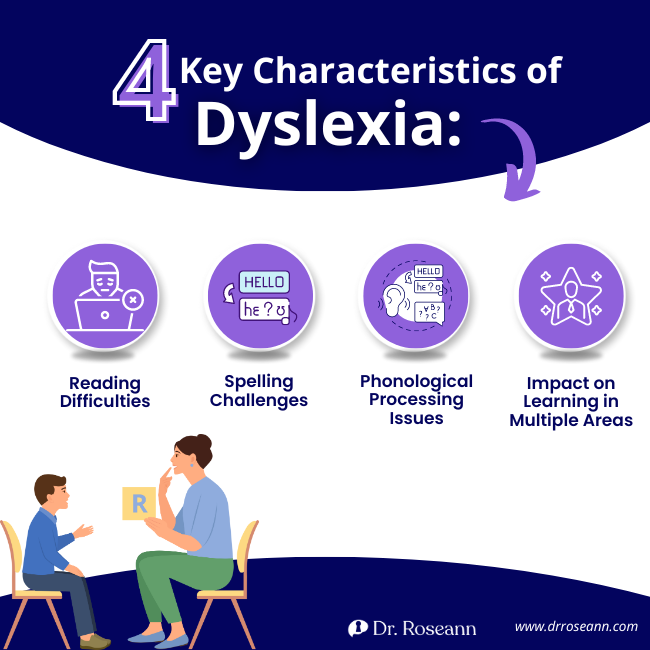
Reading Difficulties
Dyslexia often manifests as difficulties in accurate and fluent word recognition, making it challenging for individuals to decode words and grasp the mechanics of reading. This can lead to slower reading rates and difficulties comprehending text.
Spelling Challenges
People with dyslexia commonly struggle with spelling due to difficulties in recognizing and manipulating the sounds within words. Phonetic spelling may be challenging, affecting both written expression and spelling accuracy.
Phonological Processing Issues
Phonological processing, involving the ability to recognize and manipulate the sounds of spoken language, is a core area affected by dyslexia. When I assessed children, I was always careful to assess their phonological memory, phonological awareness, and rapid naming abilities, which are the core components of phonological processing.
These learning issues can impede the development of strong phonemic awareness, a crucial skill for successful reading, and impact spelling and writing. Dyslexics struggle to map the sounds to the letters because they can’t correctly process them.
Impact on Learning in Multiple Areas
Dyslexia's impact extends beyond reading and spelling; it can influence various academic and daily activities. Individuals with dyslexia may face challenges in learning new languages, mastering mathematical concepts that involve word problems, and following multi-step instructions.
Addressing Dyslexia in Education
Recognizing dyslexia early is essential for implementing effective interventions. Time and time again, as with my son, getting help early can change a child’s life trajectory. I recall working with a remarkable teen very early in my career who didn’t get help until he was almost 17. He had just about given up on his dreams until we got him the help he deserved.
On my podcast, It’s Gonna Be OK!, listening to Kat’s dyslexia story is inspiring because her parents fought hard to get her help. She is a successful college student today because her dyslexia was remediated.
Evidence-based strategies, such as structured literacy programs and multisensory approaches, can significantly benefit individuals with dyslexia (Bowers & Ramsdell, 2023). Accommodations, such as extended time for reading tasks or assistive technology, further help address their learning problems.
Educators and parents play pivotal roles in creating a supportive and understanding environment for students with dyslexia. Emphasizing strengths, fostering self-esteem, and employing tailored instructional methods contribute to the success and well-being of individuals with dyslexia in educational settings.
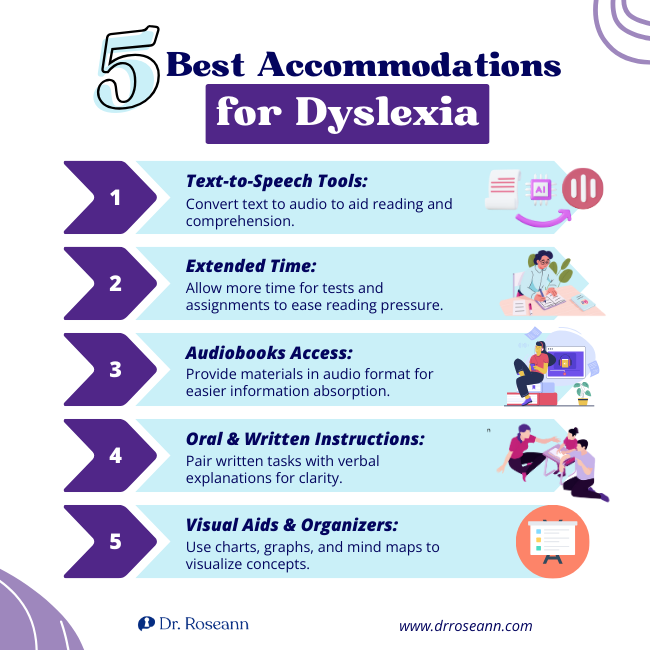
Chapter 11
The Spectrum of Mental Health
I have seen mental health conditions in children, and adults occur across a spectrum and more and more with layers of issues. While mental health issues may not officially fall under the neurodivergence umbrella, we are starting to open our thinking about how they fit into our ever-growing neurodivergent community.
There are several different mental health conditions that are often considered part of the neurodivergent group, but these are frequently co-occurring conditions.
Obsessive-Compulsive Disorder (OCD)
OCD is a mental health disorder characterized by intrusive, unwanted thoughts (obsessions) and repetitive behaviors or mental acts (compulsions) aimed at reducing distress or preventing perceived harm. While OCD is often considered an anxiety disorder, its neurobiological basis and manifestation as a repetitive behavior disorder align it with a variety of neurodivergent conditions such as ASD.
Bipolar Disorder and Mood Disorder
Bipolar disorder involves recurrent episodes of mood changes, including periods of elevated or irritable mood (mania or hypomania) and periods of depression. The neurobiological underpinnings of mood disorders, including alterations in brain structure and neurotransmitter function, contribute to this disorder being more prevalent in neurodivergents.
Post-Traumatic Stress Disorder (PTSD)
PTSD is a mental health condition triggered by experiencing or witnessing a traumatic event. It is characterized by symptoms such as intrusive memories, flashbacks, avoidance of reminders of the trauma, adverse changes in mood and cognition, and heightened arousal.
Bullying is more common for neurodivergent children, and thus, PTSD is more common. Care should taken to support the social interactions of kids who learn differently.
Chapter 12
How Do You Know If Your Child is Neurodivergent?
Determining if your child is neurodivergent involves understanding cognitive, behavioral, and sensory experiences and comparing them to typical patterns of neurological functioning. While self-diagnosis is not a substitute for professional evaluation, several signs and indicators may suggest neurodivergence. Here are some steps to help you assess if your child may be neurodivergent:
1. Educate Yourself
Learn about different neurodivergent conditions, including autism, ADHD, dyslexia, dyspraxia, and others. Understand the common traits, characteristics, and experiences associated with these conditions.
2. Reflect on Their Experiences
Reflect on your child’s cognitive, social, and sensory experiences. Consider areas where they may have struggled or excelled compared to their peers. Think about patterns of behavior, communication style, sensory sensitivities, and any other traits that may indicate neurodivergence.
3. Seek Input from Others
Talk to trusted friends, family members, or peers about your experiences and observations. They may offer insights or perspectives that you still need to consider. Others' observations of your child’s behavior and interactions can be valuable in understanding them better.
4. Assess Symptoms and Traits
Look for common symptoms and traits associated with neurodivergent conditions. These may include challenges with social interaction, communication difficulties, sensory sensitivities, executive functioning issues, and repetitive behaviors or interests.
5. Consider Developmental History
Reflect on your child’s developmental history, including childhood experiences, academic performance, and interactions with peers and authority figures. Note any significant challenges or differences compared to their peers during childhood and adolescence.
6. Consult with Professionals
If you suspect your child may be neurodivergent, consider seeking an evaluation from a qualified professional, such as a psychologist, psychiatrist, or neurologist. A thorough assessment can clarify and help you understand their strengths, challenges, and support needs.
7. Explore Personal Identity
Consider how identifying as neurodivergent may impact their sense of self and identity. Embracing neurodiversity can empower and validate, providing a framework for understanding and accepting your unique cognitive profile.
Chapter 13
How to Help a Neurodivergent Child
Supporting a neurodivergent child involves creating a nurturing environment that acknowledges and accommodates their unique strengths, challenges, and needs. Here are some strategies to help a neurodivergent child thrive:
Strategies to Help Neurodivergent Kids
1. Early Intervention
Supporting a neurodivergent child through early intervention involves seeking professional assessment and accessing specialized services such as therapy and educational programs. Collaborate with professionals to develop an individualized support plan tailored to your child's needs, and actively engage in therapy sessions and parent training programs to gain knowledge and skills to support their home development. Additionally, it provides a structured and supportive environment, promotes communication and social skills, and advocates for additional support services.
2. Individualized Education Plan (IEP)
Develop a customized plan to address the child's specific needs. The creation and implementation of an IEP requires careful consideration and collaboration. Conducting thorough assessments, setting clear goals, and fostering inclusive education environments are essential in providing tailored support.
3. Educational Therapy
Engage in specialized teaching methods tailored to the individual's learning style. Educational therapy plays a pivotal role in addressing the unique needs of a child with a learning disability. Diagnostic assessments, multisensory techniques, collaboration with specialists, and ongoing progress monitoring contribute to a holistic and personalized approach to learning support.
4. Positive Reinforcement
Foster a supportive and encouraging environment. Beyond formal interventions, positive reinforcement is crucial for a child's well-being. Celebrate small victories and foster a positive learning environment. Providing continuous encouragement contributes to building the child's confidence and motivation.
5. Family Involvement
Establish a collaborative partnership with parents and caregivers. Involving families in the support process enhances the overall effectiveness of interventions. Open communication, sharing observations, and including parents in decision-making create a united front for the child's well-being.
6. Inclusive Practices
Supporting a neurodivergent child through inclusive practices involves creating an environment that celebrates diversity and accommodates individual differences. Implement flexible learning formats, sensory-friendly spaces, and peer support networks to ensure all children feel valued and included. Encourage empathy, understanding, and acceptance among peers and educators to foster a sense of belonging and promote positive social interactions.
The BrainBehaviorResetTM Program provides holistic and integrative mental health support for individuals with various neurodevelopmental conditions, including ADHD, autism spectrum disorder (ASD), learning disabilities, anxiety, and mood disorders. Find out if your child is neurodivergent by taking the Am I Neurodivergent Quiz.
What is neurodiversity?
Neurodiversity is the spectrum of variations in neurological structure and function found among individuals. It encompasses differences in cognition, behavior, sensory processing, and communication styles, highlighting the richness and diversity of human neurological makeup.
What is considered neurodivergence?
Neurodivergent individuals have unique cognitive strengths and challenges, sensory sensitivities, communication styles, and ways of processing information. Embracing neurodiversity involves recognizing and respecting these differences, promoting inclusivity and acceptance, and providing support and accommodations to enable neurodivergent individuals to thrive in diverse environments.
What are the 7 main types of learning disabilities?
The seven main types of learning disorders are dyslexia, dysgraphia, dyscalculia, auditory processing disorder, visual processing disorder, non-verbal learning disabilities, and ADHD. Each type of LD disorder presents specific challenges in areas such as reading, writing, math, auditory or visual processing, non-verbal skills, and attention and impulse control.
What qualifies as neurodivergent?
Individuals who have been diagnosed with neurodevelopmental conditions such as autism, ADHD, dyslexia, dyspraxia, or Tourette syndrome are considered neurodivergent. Additionally, those who exhibit neurocognitive traits outside the typical range, even without a formal diagnosis, can also be regarded as neurodivergent.
Is anxiety neurodivergent?
Anxiety itself is not typically considered neurodivergent, as it is a common human experience and can occur in individuals across the neurotypical spectrum. However, anxiety disorders, which involve persistent and excessive feelings of anxiety or worry that significantly impact daily functioning, may be associated with neurodivergence in some cases, particularly when they co-occur with other neurodevelopmental conditions or are part of a broader neurodivergent profile.
What are the causes of a learning disability?
Various factors, including genetic influences, neurological differences, and environmental factors during prenatal or early childhood development, can cause learning disability. The other causes of disorders like dyslexia and learning difficulties in the classroom are premature birth, exposure to toxins, or a family history of learning disabilities, which may contribute to the onset of these challenges.
Is ADD a learning disability or a neurodivergent condition?
Attention Deficit Disorder (ADD) is not considered a separate diagnosis but is often used interchangeably with Attention Deficit Hyperactivity Disorder (ADHD). ADHD is recognized as among the neurodevelopmental disabilities that affect learning, behavior, and executive functioning, but it is not categorized as a learning disability.
How many learning disabilities are there?
There are several types of learning disabilities, and they can manifest in various ways. There are around 15 to 20 recognized types of learning disabilities, encompassing conditions like dyslexia and dyscalculia, among others.
Is an IEP a disability support?
An Individualized Education Plan (IEP) is a legally binding document designed to support and accommodate students with disabilities. When used with qualifying disabilities for IEP, the program outlines specific educational goals, services, and adaptations tailored to meet the individual needs of students with learning impairments, ensuring they receive an inclusive and appropriate education.
How do you diagnose a learning disability?
Diagnosing a learning disability typically involves a comprehensive assessment conducted by educational psychologists or other qualified professionals. Currently, the diagnosis of learning disabilities is based on a comprehensive assessment conducted by qualified professionals, which includes standardized tests, observations, interviews, and a review of academic and developmental history.
What is neurodivergent testing?
Neurodivergent testing involves assessments and evaluations conducted to identify and understand individuals' neurodevelopmental conditions, cognitive differences, and neurological variations. These tests may include standardized measures, observations, interviews, and specialized assessments administered by professionals trained in diagnosing neurodivergent conditions, such as psychologists, psychiatrists, pediatricians, or neurologists.
How do learning disabilities affect students?
Learning disabilities can significantly impact students by affecting their ability to acquire, process, and express information, leading to difficulties in academic achievement. These challenges may manifest in reading, writing, math, and attention, creating unique learning needs that require tailored interventions and support.
How many students have learning disabilities?
Estimates suggest that around 5-15% of the global population may have learning disabilities. However, the prevalence can vary based on factors such as the definition of learning disabilities and the criteria used for diagnosis (Margolis et al., 2020). It's important to note that these figures are general estimates, and the actual prevalence may vary across different regions and populations.
What does it mean to have a language-based learning disability?
A language-based learning disability is a condition where difficulties primarily affect the processing of linguistic information, impacting areas such as reading, spelling, writing, and sometimes, listening or speaking.
How to overcome learning disabilities?
Overcoming learning disabilities often involves a multi-faceted approach, including personalized interventions, specialized educational strategies, and consistent support. Individualized accommodations, targeted therapies, and a positive learning environment can empower individuals with learning disabilities to build on their strengths and succeed academically and personally.
What are some of the specific symptoms associated with dyslexia?
Specific dyslexia symptoms may include challenges in phonological processing, difficulty recognizing and decoding words, problems with reading fluency, and challenges in spelling and writing. Individuals with dyslexia may also experience difficulty with tasks involving sequential processing, such as following instructions, and may exhibit a discrepancy between their intellectual ability and reading achievement.
Can a pediatrician diagnose dyslexia?
While pediatricians may observe signs of potential learning difficulties, they are typically not the primary professionals who diagnose dyslexia. A comprehensive evaluation by specialized professionals, such as educational psychologists or neuropsychologists, is essential for an accurate diagnosis.
Do learning disabilities go away?
Learning disabilities are typically lifelong, but with appropriate interventions, accommodations, and support, individuals can develop strategies to manage their challenges and succeed in various aspects of life. While the core difficulties may persist, the impact of learning disabilities can be minimized, allowing individuals to adapt and thrive.
Can learning difficulties be cured?
Learning difficulties are not typically “cured,” as they are often neurodevelopmental. However, with early intervention, tailored support, and effective educational strategies, individuals with learning difficulties can significantly improve their skills and overcome challenges, enabling them to succeed academically and in other areas of life.
Citations
Bowers, L. M., & Ramsdell, H. L. (2023). Rethinking Literacy Intervention: Addressing a Practice Gap With Best Practices From Multisensory Structured Language Approaches. LSHSS, 55(3), 1–16. https://doi.org/10.1044/2023_lshss-22-00133
Erbeli, F., Hart, S. A., & Taylor, J. (2018). Genetic and Environmental Influences on Achievement Outcomes Based on Family History of Learning Disabilities Status. Journal of Learning Disabilities, 52(2), 135–145. https://doi.org/10.1177/0022219418775116
Kovas, Y., Haworth, C. M. A., Dale, P. S., Plomin, R., Weinberg, R. A., Thomson, J. M., & Fischer, K. W. (2007). The Genetic and Environmental Origins of Learning Abilities and Disabilities in the Early School Years. Monographs of the Society for Research in Child Development, 72(3), i–156. https://www.jstor.org/stable/30163178
Margolis, A. E., Broitman, J., Davis, J. M., Alexander, L., Hamilton, A., Liao, Z., Banker, S., Thomas, L., Ramphal, B., Salum, G. A., Merikangas, K., Goldsmith, J., Paus, T., Keyes, K., & Milham, M. P. (2020). Estimated Prevalence of Nonverbal Learning Disability Among North American Children and Adolescents. JAMA Network Open, 3(4), e202551–e202551. https://doi.org/10.1001/jamanetworkopen.2020.2551
Pennington, B. F. (1995). Genetics of Learning Disabilities. Journal of Child Neurology, 10(1_suppl), S69–S77. https://doi.org/10.1177/08830738950100s114
Dr. Roseann is a mental health expert in Mental Health who frequently is in the media:
- Helping Children Thrive Podcast Benefits of Neurofeedback for children with ADHD
- Very Well Mind What Is Asperger Syndrome?
- CBS (Video) Student Learning Resources Quarantine
Always remember… “Calm Brain, Happy Family™”
Disclaimer: This article is not intended to give health advice and it is recommended to consult with a physician before beginning any new wellness regime. *The effectiveness of diagnosis and treatment vary by patient and condition. Dr. Roseann Capanna-Hodge, LLC does not guarantee certain results.
Are you looking for SOLUTIONS for your struggling child or teen?
Dr. Roseann and her team are all about science-backed solutions, so you are in the right place!
Grab your complimentary copy of
147 Therapist-Endorsed Self-Regulation Strategies for Children: A Practical Guide for Parents
Dr. Roseann is a Children’s Mental Health Expert and Licensed Therapist who has been featured in/on hundreds of media outlets including The Mel Robbins Show, CBS, NBC, PIX11 NYC, Today, FORBES, CNN, The New York Times, The Washington Post, Business Insider, Women’s Day, Healthline, CNET, Parade Magazine and PARENTS. FORBES called her, “A thought leader in children’s mental health.”

She coined the terms, “Re-entry panic syndrome” and “eco-anxiety” and is a frequent contributor to media on mental health.
Dr. Roseann Capanna-Hodge has three decades of experience in working with children, teens and their families with attention-deficit hyperactivity disorder (ADHD), autism, concussion, dyslexia and learning disability, anxiety, Obsessive Compulsive Disorder (OCD), depression and mood disorder, Lyme Disease, and PANS/PANDAS using science-backed natural mental health solutions such as supplements, magnesium, nutrition, QEEG Brain maps, neurofeedback, PEMF, psychotherapy and other non-medication approaches.
She is the author of three bestselling books, It’s Gonna Be OK!: Proven Ways to Improve Your Child's Mental Health, The Teletherapy Toolkit, and Brain Under Attack. Dr. Roseann is known for offering a message of hope through science-endorsed methods that promote a calm brain.
Her trademarked BrainBehaviorResetⓇ Program and It’s Gonna be OK!Ⓡ Podcast has been a cornerstone for thousands of parents facing mental health, behavioral or neurodevelopmental challenges.
She is the founder and director of The Global Institute of Children’s Mental Health, Neurotastic™Brain Formulas and Dr. Roseann Capanna-Hodge, LLC. Dr. Roseann is a Board Certified Neurofeedback (BCN) Practitioner, a Board Member of the Northeast Region Biofeedback Society (NRBS), Certified Integrative Mental Health Professional (CIMHP) and an Amen Clinic Certified Brain Health Coach. She is also a member of The International Lyme Disease and Associated Disease Society (ILADS), The American Psychological Association (APA), Anxiety and Depression Association of America (ADAA) National Association of School Psychologists (NASP), International OCD Foundation (IOCDF).
© Roseann-Capanna-Hodge, LLC 2024


